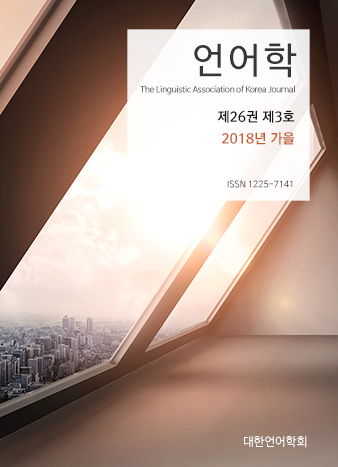대한언어학회 전자저널

26권 3호 (2018년 9월)
- 한국어 속담의 영어 기계번역에 미치는 격조사의 영향 —구글번역기를 중심으로—
-
김경숙
Pages : 139-157
Abstract
Kim, Kyungsook. (2018). The influence of Case markers on the machine-translation of Korean proverbs into English. The Linguistic Association of Korea Journal, 26(3), 139-157. This study investigates the influence of case markers on the machine-translation of Korean proverbs into English. While grammatical roles are determined by the word order in English, they are indicated by case markers in Korean. The problem is that Korean case markers are optionally deleted. It is, therefore, hypothesized that the presence of case markers in the original text is to be crucially important to the success rate of machine-translation from Korean into English. For this study, the characteristics of Google Translate, the translation system used here, were first surveyed. Then, sentences from three different categories of Korean texts (spoken, written, and proverb texts) were chosen and machine-translated using Google Translate. The findings are as follows. First, the Korean-English machine-translation of three different text types shows that there were more syntactic errors than lexical errors across the categories. Second, there were more errors in complex sentences than in simplex sentences. Third, the error rate was highest in the proverb category and lowest in the written text category. Fourth, across the three categories, the error rate was the highest when deletion of case markers or multi-case markers was involved. Lastly, the supplement of missing case markers to the original Korean proverbs substantially enhanced the success rate of machine-translation. This shows that the presence of case markers plays a crucial role in machine-translation into English, which, in turn, suggests that we can improve the success rate of machine-translation from Korean into English if we add the missing case markers to the Korean input sentences.
Keywords
# 구글번역기(Google Translate) # 한영 기계번역(Korean-English machine translation) # 격조사(case markers) # 번역 오류(translation error) # 통사오류(syntactic error) # 속담(proverbs)
References
- 김원경. (2009). 한국어의 격. 서울: 박문사.
- 김원경. (2011). 격조사의 정보와 기계번역: 한-영 번역중심으로. 한국어의미학, 35, 23-43.
- 남기심, 고영근. (2010). 표준국어문법론. 서울: 탑출판사.
- 박영란. (2017). 기계번역에서의 영어 속담 분석. 한국통번역교육회 학술대회 자료집, 58-61.
- 박홍원, 심재석, 이수진, 석영민, 오승훈. (2001). 한영 번역 시스템에서의 불특정 조사를 포함한 용언구 처리. 한국정보과학회 언어공학연구회 학술발표 논문집, 523-529.
- 배명진, 김명숙. (2013). 소리로 읽는 세상. 김영사.
- 배지연. (2011). 한영 기계번역의 격 실현. 세종대학교 대학원 박사학위논문.
- 배지연, 김수연. (2010). 한영 기계번역에 있어서 격 실현 현상 고찰. 언어과학, 17(4), 99-120.
- 엄정호. (2011). 격의 개념과 한국어의 조사. 국어학, 62, 199-223.
- 이병희. (1994). 한/영 기계번역 시스템을 위한 시제 도우미의 설계와 구현. 인터넷정보학회논문지, 2(4), 55-67.
- 이종근. (2018). 한국어 격표지의 본질과 초점. 언어연구, 33(4), 733-755.
- 이하규, 김영택. (1994). 기계번역을 위한 한국어 숙어의 표현 및 인식. 정보과학회논문지, 21(1), 139-149.
- 이호승. (2006). 격조사 없는 명사구의 격 문제에 대하여. 어문학, 93, 139-159.
- 이호승. (2012). 국어 격 범주의 성격과 격 체계의 설정. 어문학, 117, 39-67.
- 임홍빈. (2007). 한국어 무조사 명사구의 통사와 의미. 국어학, 49, 69-106.
- 조준모, 이상조. (1994). 한ㆍ영 기계 번역을 위한 부사의 위치 및 순서제약 해결의 방안 및 구현. 한국정보과학회 언어공학연구회 학술발표 논문집, 163-167.
- 최재혁, 김권양, 박상규, 이상조. (1989). 한영 기계번역을 위한 조사 사전구성에 관한 연구. 한국정보과학회 언어공학연구회 학술발표 논문집, 219-224.
- 홍기선. (2017). 한국어의 조사 ‘가’와 ‘를’: 격과 의미. 언어, 42(4), 961-988.